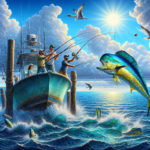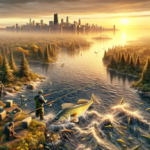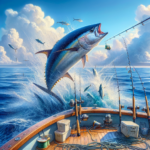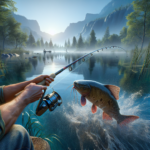Mahi-Mahi Fishing in Florida’s Gulf Coast

Introduction
Did you know that the Gulf Coast of Florida is one of the premier destinations for Mahi-Mahi fishing in the United States? This vibrant, fast-swimming fish, also known as dolphinfish, is not only a thrill to catch but also a delight to eat. In this article, we will explore the ins and outs of Mahi-Mahi fishing along Florida’s Gulf Coast, covering everything from the best fishing techniques and gear to the top fishing spots and seasonal considerations.
Whether you are a seasoned angler or a novice looking to try your hand at fishing, understanding the nuances of Mahi-Mahi fishing in this region can significantly enhance your experience. We will delve into the historical and cultural significance of fishing in this area, provide detailed information on the species, and offer practical tips and best practices to ensure a successful fishing trip.
Background/Context
Historical or Cultural Significance
Fishing has been an integral part of Florida’s culture and economy for centuries. The Gulf Coast, in particular, has a rich history of commercial and recreational fishing. Mahi-Mahi, with its striking colors and acrobatic leaps, has long been a favorite among local anglers and tourists alike. The fish’s popularity is not just due to its sporting qualities but also its culinary appeal, making it a prized catch in the region.
Geographical Overview
The Gulf Coast of Florida stretches from the Panhandle down to the southwestern tip of the state, encompassing a diverse range of ecosystems. The warm, nutrient-rich waters of the Gulf of Mexico provide an ideal habitat for Mahi-Mahi, especially during the warmer months. The region’s climate is characterized by hot, humid summers and mild winters, making it a year-round fishing destination.
Key Points/Details
Fishing Techniques
Technique Overview
Mahi-Mahi are known for their aggressive feeding habits, making them an exciting target for various fishing techniques. The most common methods include trolling, drift fishing, and casting. Trolling involves dragging lures or bait behind a moving boat, while drift fishing allows the boat to move with the current, presenting bait naturally. Casting involves throwing lures or bait into the water and retrieving them to mimic the movement of prey.
When and Where to Use
Trolling is particularly effective in open waters where Mahi-Mahi are often found chasing schools of baitfish. Drift fishing works well near floating debris or weed lines, where these fish tend to congregate. Casting is ideal for targeting Mahi-Mahi that are visible near the surface or around structures.
Recommended Gear
- Rods: Medium to heavy-action rods, around 6-7 feet in length.
- Reels: High-speed spinning or conventional reels with a good drag system.
- Lines: 20-50 lb braided or monofilament lines.
- Bait/Lures: Live bait such as ballyhoo or squid, and artificial lures like trolling skirts, jigs, and poppers.
Species Information
Species Overview
Mahi-Mahi (Coryphaena hippurus) are pelagic fish known for their vibrant blue, green, and yellow coloration. They are fast swimmers and can grow up to 4-5 feet in length, weighing between 20-50 pounds on average. Mahi-Mahi are found in warm waters worldwide and are particularly abundant in the Gulf of Mexico during the summer months.
Best Practices
To successfully catch Mahi-Mahi, it’s essential to use the right techniques and gear. Trolling at speeds of 6-8 knots with brightly colored lures can attract these fish from a distance. When drift fishing, look for floating debris or weed lines, as Mahi-Mahi often gather around these structures. Using live bait can increase your chances of a successful catch, as these fish are opportunistic feeders.
Location Information
Top Fishing Spots
- Destin: Known as the “World’s Luckiest Fishing Village,” Destin offers excellent offshore fishing opportunities for Mahi-Mahi.
- Panama City Beach: This area is famous for its deep-sea fishing charters that target Mahi-Mahi and other pelagic species.
- Clearwater: With its clear waters and abundant marine life, Clearwater is a prime spot for Mahi-Mahi fishing.
- Key West: The waters around Key West are teeming with Mahi-Mahi, especially during the summer months.
Regulations and Licenses
Before heading out, it’s crucial to familiarize yourself with local fishing regulations. In Florida, anglers need a saltwater fishing license, which can be obtained online or at local retailers. There are also specific regulations regarding the size and bag limits for Mahi-Mahi, so make sure to check the latest guidelines from the Florida Fish and Wildlife Conservation Commission (FWC).
Seasonal Considerations
Seasonal Variations
Fishing conditions in the Gulf Coast can vary significantly throughout the year. Mahi-Mahi are most abundant during the warmer months, from late spring to early fall. During this period, the fish migrate closer to shore, making them more accessible to anglers. In the winter months, Mahi-Mahi are typically found further offshore, requiring longer trips to reach productive fishing grounds.
Best Times to Fish
The optimal time for Mahi-Mahi fishing in Florida’s Gulf Coast is from May to September. Early morning and late afternoon are generally the best times of day to fish, as Mahi-Mahi are more active during these periods. However, they can be caught throughout the day, especially if you locate a productive area with plenty of baitfish.
Events and Tournaments
Event Overview
The Gulf Coast hosts several fishing tournaments that feature Mahi-Mahi as a target species. These events attract anglers from all over the country and offer substantial prizes for the largest catches.
Preparation Tips
To prepare for a fishing tournament, make sure your gear is in top condition and practice your techniques beforehand. Research the tournament rules and regulations, and plan your strategy based on the expected conditions and competition. It’s also a good idea to scout the fishing area in advance to identify potential hotspots.
Tips and Best Practices
General Tips
- Always keep an eye out for birds diving into the water, as this often indicates the presence of baitfish and, consequently, Mahi-Mahi.
- Use a variety of lures and baits to see what the fish are biting on that day.
- Maintain a steady trolling speed to keep your lures at the right depth and action.
Avoid Common Mistakes
- Don’t ignore floating debris or weed lines, as these are prime areas for Mahi-Mahi.
- Avoid using gear that is too light, as Mahi-Mahi are strong fighters and can easily break weak lines.
- Don’t forget to check local regulations and obtain the necessary licenses before heading out.
Advanced Techniques
- Try using a chum line to attract Mahi-Mahi to your boat. This can be particularly effective when drift fishing.
- Experiment with different trolling patterns and speeds to find what works best on a given day.
- Use a downrigger to get your lures deeper if the fish are not biting near the surface.
Gear and Equipment Recommendations
Essential Gear
- Medium to heavy-action rods
- High-speed spinning or conventional reels
- 20-50 lb braided or monofilament lines
- Live bait such as ballyhoo or squid
- Artificial lures like trolling skirts, jigs, and poppers
Optional Gear/Upgrades
- Downriggers for deeper trolling
- Chum buckets to attract fish
- Fish finders to locate schools of baitfish and Mahi-Mahi
Where to Buy or Rent
Local tackle shops in coastal towns like Destin, Panama City Beach, and Clearwater offer a wide range of fishing gear and equipment. Many shops also provide rental options for those who do not want to invest in their own gear. Online retailers like Bass Pro Shops and Cabela’s are also excellent sources for purchasing fishing equipment.
Safety and Conservation
Safety Tips
- Always check the weather forecast before heading out, as conditions can change rapidly in the Gulf of Mexico.
- Wear a life jacket and ensure all safety equipment on your boat is in good working order.
- Stay hydrated and protect yourself from the sun with sunscreen, hats, and sunglasses.
Conservation Practices
- Practice catch and release for smaller fish to help maintain healthy populations.
- Follow local regulations regarding size and bag limits.
- Avoid disturbing marine life and habitats, and dispose of trash properly.
Planning Your Trip
Accommodations
There are numerous accommodation options along Florida’s Gulf Coast, ranging from budget-friendly motels to luxury resorts. Popular areas like Destin, Panama City Beach, and Clearwater offer a variety of lodging choices to suit different preferences and budgets.
Travel Tips
The Gulf Coast is easily accessible by car, with major highways connecting the region to other parts of Florida and neighboring states. Several airports, including Northwest Florida Beaches International Airport (ECP) and Tampa International Airport (TPA), provide convenient access for those traveling by air. Renting a car is recommended for exploring the area and reaching different fishing spots.
Additional Activities
In addition to fishing, the Gulf Coast offers a wide range of activities for visitors. Enjoy beautiful beaches, water sports, and nature trails, or explore local attractions such as the Florida Aquarium in Tampa and the National Naval Aviation Museum in Pensacola. The region also boasts excellent dining options, with many restaurants serving fresh seafood and local specialties.
Frequently Asked Questions (FAQs)
Do I need a fishing license to fish for Mahi-Mahi in Florida?
Yes, a saltwater fishing license is required for both residents and non-residents. Licenses can be obtained online or at local retailers.
What is the best time of year to fish for Mahi-Mahi in the Gulf Coast?
The best time to fish for Mahi-Mahi in Florida’s Gulf Coast is from May to September, when the fish are most abundant and closer to shore.
What type of bait should I use for Mahi-Mahi?
Live bait such as ballyhoo or squid is highly effective for Mahi-Mahi. Artificial lures like trolling skirts, jigs, and poppers also work well.
Are there any size or bag limits for Mahi-Mahi in Florida?
Yes, there are specific regulations regarding the size and bag limits for Mahi-Mahi. It’s important to check the latest guidelines from the Florida Fish and Wildlife Conservation Commission (FWC) before heading out.
Conclusion
Mahi-Mahi fishing along Florida’s Gulf Coast offers an exhilarating experience for anglers of all skill levels. By understanding the best techniques, gear, and locations, you can increase your chances of a successful and enjoyable fishing trip. Remember to follow local regulations, practice conservation, and prioritize safety to ensure a positive impact on the environment and future fishing opportunities. Whether you’re planning a solo adventure or a family vacation, the Gulf Coast’s abundant marine life and beautiful scenery make it a top destination for fishing enthusiasts.




